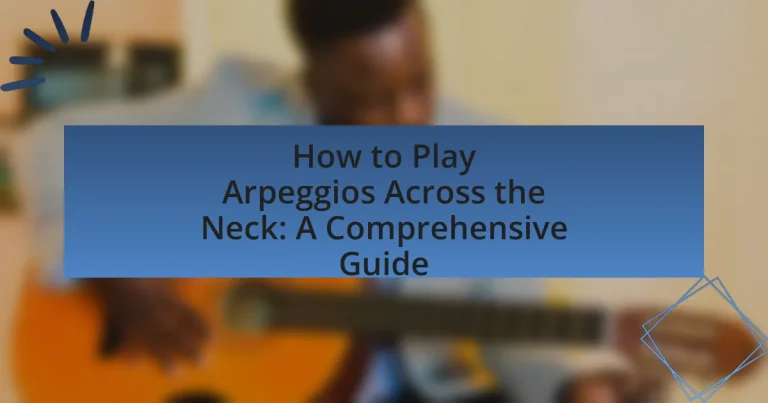Arpeggios are a fundamental musical technique involving the sequential playing of chord notes, crucial for enhancing melody and harmony across various genres. This comprehensive guide covers the definition, importance, and components of arpeggios, as well as their differences from other techniques. It explores the various types of arpeggios, essential techniques for guitarists, and effective practice methods to improve proficiency. Additionally, the article addresses common challenges faced by musicians and offers strategies for incorporating arpeggios into improvisation and songwriting, ultimately aiming to enhance musical expression and technical skill.

What are Arpeggios and Why are They Important in Music?
Arpeggios are musical techniques that involve playing the notes of a chord in a sequential manner rather than simultaneously. They are important in music because they create melodic lines that enhance harmony and provide a sense of movement within a piece. Arpeggios allow musicians to explore different tonalities and add complexity to their compositions, making them essential for various genres, including classical, jazz, and contemporary music. The use of arpeggios can be traced back to early music theory, where they were utilized to develop intricate musical phrases and improve improvisational skills.
How do Arpeggios differ from other musical techniques?
Arpeggios differ from other musical techniques primarily in their method of playing notes, as they involve playing the individual notes of a chord sequentially rather than simultaneously. This technique creates a flowing, melodic line that contrasts with techniques like strumming, where chords are played all at once, or scales, which focus on a linear sequence of notes without the harmonic context of chords. The distinct sound of arpeggios is often utilized in various genres to add texture and complexity, making them a fundamental aspect of composition and performance in music.
What are the basic components of an Arpeggio?
An arpeggio consists of three basic components: the root note, the third, and the fifth. The root note serves as the foundation of the arpeggio, while the third determines the chord’s quality (major or minor), and the fifth adds harmonic stability. These components are derived from the chord structure, where the root, third, and fifth notes are played in succession, creating a melodic line that outlines the chord. This structure is fundamental in music theory and is widely used in various musical genres to create texture and movement.
Why are Arpeggios essential for guitarists?
Arpeggios are essential for guitarists because they enhance musical expression and technical proficiency. By breaking chords into individual notes, arpeggios allow guitarists to create melodic lines that complement harmonic structures, facilitating more intricate compositions. Furthermore, practicing arpeggios improves finger dexterity and coordination, which are crucial for executing complex passages in various musical styles. Studies show that guitarists who incorporate arpeggios into their practice routines develop a deeper understanding of music theory and improve their improvisational skills, making them more versatile musicians.
What are the different types of Arpeggios?
The different types of arpeggios include major arpeggios, minor arpeggios, diminished arpeggios, augmented arpeggios, and seventh arpeggios. Major arpeggios consist of the root, major third, and perfect fifth, while minor arpeggios include the root, minor third, and perfect fifth. Diminished arpeggios are formed by the root, minor third, and diminished fifth, and augmented arpeggios consist of the root, major third, and augmented fifth. Seventh arpeggios add a seventh degree to the basic triads, resulting in major seventh, minor seventh, dominant seventh, and diminished seventh arpeggios. Each type serves distinct harmonic functions in music theory and composition.
How do Major and Minor Arpeggios differ?
Major and minor arpeggios differ primarily in their tonal quality and structure. Major arpeggios consist of the root, major third, and perfect fifth, creating a bright and uplifting sound, while minor arpeggios include the root, minor third, and perfect fifth, resulting in a darker and more somber tone. This distinction is rooted in the intervals that define each type; the major third interval in major arpeggios contrasts with the minor third interval in minor arpeggios, which fundamentally alters the emotional character of the music produced.
What are Extended and Altered Arpeggios?
Extended arpeggios are arpeggios that include additional notes beyond the basic triad, often incorporating the seventh, ninth, eleventh, or thirteenth degrees of the scale. Altered arpeggios, on the other hand, modify the standard chord tones by raising or lowering specific notes, such as the fifth or ninth, to create tension and color in the harmony. Both techniques are commonly used in jazz and contemporary music to enhance melodic and harmonic complexity, allowing musicians to explore a wider range of sounds and expressions.

How to Play Arpeggios Across the Neck?
To play arpeggios across the neck, position your fingers on the fretboard to outline the notes of a chord in sequence, typically starting from the root note. For example, if playing a C major arpeggio, play the notes C, E, and G in succession across different strings and frets. This technique allows for fluid movement and exploration of various voicings. Practicing arpeggios in different positions enhances finger dexterity and familiarity with the fretboard, enabling musicians to incorporate them seamlessly into their playing.
What are the basic techniques for playing Arpeggios on the guitar?
The basic techniques for playing arpeggios on the guitar include fingerpicking, alternate picking, and sweep picking. Fingerpicking involves plucking the strings with the fingers, allowing for a smooth and flowing sound. Alternate picking requires using a pick to alternate between downstrokes and upstrokes, which increases speed and precision. Sweep picking is a technique where the pick sweeps across multiple strings in a single motion, enabling rapid note sequences. These techniques are foundational for executing arpeggios effectively, as they enhance both speed and clarity in performance.
How do you position your fingers for optimal play?
To position your fingers for optimal play, place your fingers in a curved shape over the strings, ensuring that each fingertip makes contact with the string directly behind the fret. This positioning allows for clear notes and minimizes buzzing. Proper finger placement involves using the tips of your fingers rather than the pads, which provides better control and precision. Additionally, maintaining a relaxed hand posture helps to facilitate fluid movement across the neck, enhancing overall playability.
What picking techniques enhance Arpeggio playing?
Alternate picking and sweep picking are two techniques that significantly enhance arpeggio playing. Alternate picking involves using a consistent down-up motion with the pick, allowing for greater speed and fluidity when playing arpeggios. This technique is particularly effective for achieving a clean and articulate sound, as it helps maintain even note spacing. Sweep picking, on the other hand, utilizes a single, smooth motion across multiple strings, which allows for rapid execution of arpeggios with minimal effort. This technique is especially useful for playing arpeggios in a more legato style, creating a seamless flow between notes. Both techniques are widely used by guitarists in various genres, demonstrating their effectiveness in enhancing arpeggio performance.
How can you practice Arpeggios effectively?
To practice arpeggios effectively, focus on consistent and structured practice sessions that incorporate various techniques. Begin by selecting a specific arpeggio pattern, such as major or minor triads, and practice it slowly to ensure accuracy in finger placement and timing. Gradually increase the tempo as you become more comfortable, using a metronome to maintain a steady rhythm. Additionally, practice arpeggios across different positions on the neck to enhance your familiarity with the fretboard. Research indicates that varied practice leads to improved muscle memory and overall proficiency in playing arpeggios.
What exercises can help improve your Arpeggio skills?
To improve your arpeggio skills, practice exercises such as the three-note-per-string arpeggio patterns, which involve playing arpeggios across different strings and positions on the neck. These exercises enhance finger dexterity and familiarity with the fretboard. Additionally, incorporating sweep picking techniques can further refine your arpeggio execution, allowing for smoother transitions between notes. Studies in music pedagogy indicate that consistent practice of these exercises leads to improved technical proficiency and musicality in arpeggio playing.
How do you incorporate a metronome into your practice?
Incorporating a metronome into practice involves setting it to a slow tempo and gradually increasing the speed as proficiency improves. Musicians should start by playing simple arpeggio patterns in time with the metronome, ensuring each note is clear and evenly spaced. This method enhances timing and rhythm, which are crucial for playing arpeggios accurately. Research shows that consistent metronome use can significantly improve a musician’s timing skills, as evidenced by studies indicating that rhythmic training leads to better performance outcomes.

What are the common challenges when playing Arpeggios?
Common challenges when playing arpeggios include maintaining consistent timing, achieving smooth transitions between notes, and ensuring proper finger positioning. Musicians often struggle with timing due to the need for precise rhythmic execution, which can be difficult when playing quickly. Smooth transitions are hindered by the complexity of finger movements required to navigate different strings and frets, leading to potential stumbling or missed notes. Additionally, improper finger positioning can result in tension or discomfort, affecting overall performance. These challenges are frequently encountered by both beginners and advanced players, highlighting the importance of focused practice and technique refinement.
Why do beginners struggle with Arpeggios?
Beginners struggle with arpeggios primarily due to a lack of finger dexterity and coordination. This difficulty arises because arpeggios require precise finger placement and timing to play individual notes in a sequence, which can be challenging for those who are still developing their basic skills. Additionally, beginners often face challenges in understanding the underlying music theory, such as chord structures and how arpeggios relate to them, which can further complicate their ability to practice effectively.
What are the most frequent mistakes made while playing Arpeggios?
The most frequent mistakes made while playing arpeggios include inconsistent timing, incorrect finger positioning, and lack of dynamic control. Inconsistent timing occurs when players do not maintain a steady rhythm, which disrupts the flow of the arpeggio. Incorrect finger positioning can lead to awkward hand movements and hinder the ability to play smoothly. Lack of dynamic control results in a flat sound, as players fail to vary the volume and intensity of notes, making the arpeggio less expressive. These mistakes can significantly affect the overall quality of the performance.
How can you overcome these challenges?
To overcome the challenges of playing arpeggios across the neck, practice consistently using a structured approach. Focus on breaking down the arpeggio patterns into manageable sections, allowing for gradual mastery of each segment. Utilize a metronome to maintain a steady tempo, which aids in developing timing and precision. Additionally, incorporate finger exercises that target dexterity and strength, as these are crucial for fluid movement across the fretboard. Research indicates that consistent practice, particularly in small increments, leads to improved muscle memory and technique retention, as supported by studies on motor skill acquisition in musicians.
How can you apply Arpeggios in your music?
You can apply arpeggios in your music by incorporating them into melodies, harmonies, and improvisations. Arpeggios allow musicians to outline chords in a more dynamic way, creating movement and interest in compositions. For example, using arpeggios in a solo can enhance the emotional impact of a piece, as they provide a flowing, melodic contour that complements the harmonic structure. Additionally, studies show that arpeggios can improve technical proficiency on instruments, as they require precise finger placement and timing, which are essential skills for musicians.
What role do Arpeggios play in improvisation?
Arpeggios serve as essential building blocks in improvisation by outlining the harmonic structure of a piece. They allow musicians to create melodic lines that are closely tied to the underlying chords, enhancing the coherence of the improvisation. By using arpeggios, performers can emphasize chord tones, which helps to establish a strong connection between the melody and harmony. This technique is widely utilized in various genres, including jazz and classical music, where improvisation is a key element. The effectiveness of arpeggios in improvisation is supported by their ability to provide a clear framework for melodic development, making them a fundamental tool for musicians seeking to enhance their improvisational skills.
How can you use Arpeggios in songwriting?
Arpeggios can be used in songwriting to create melodic lines that enhance harmonic progressions. By breaking chords into individual notes, songwriters can add texture and movement to their compositions. For example, using arpeggios allows for smoother transitions between chords and can evoke different emotional responses, as seen in genres like classical and pop music. The effectiveness of arpeggios in songwriting is supported by their historical use in compositions by artists such as Bach and contemporary musicians, demonstrating their versatility and impact on musical storytelling.
What are some tips for mastering Arpeggios across the neck?
To master arpeggios across the neck, practice consistently using various fingerings and positions. This involves learning the shapes of major, minor, and seventh arpeggios in different keys and applying them across the fretboard. Additionally, utilize a metronome to develop timing and speed, starting slowly and gradually increasing tempo as proficiency improves. Incorporating these techniques into your practice routine will enhance your ability to navigate the neck fluidly. Regularly playing along with backing tracks or other musicians can also reinforce your skills in a musical context.
How can you develop muscle memory for Arpeggios?
To develop muscle memory for arpeggios, practice them consistently using slow, deliberate movements. This approach allows the fingers to learn the specific patterns and positions required for each arpeggio. Research indicates that repetitive practice enhances neural pathways associated with motor skills, leading to improved muscle memory. For example, a study published in the Journal of Neuroscience found that consistent practice of finger movements significantly increased the efficiency of neural circuits involved in those movements. Therefore, by regularly practicing arpeggios at a slow tempo and gradually increasing speed, musicians can effectively build muscle memory.
What are the best practices for integrating Arpeggios into your playing style?
The best practices for integrating arpeggios into your playing style include consistent practice, understanding the chord tones, and applying them in various musical contexts. Consistent practice involves regularly incorporating arpeggios into your warm-up routines to build muscle memory and familiarity. Understanding the chord tones means knowing which notes belong to each chord, allowing for more expressive playing. Applying arpeggios in various musical contexts, such as improvisation or composition, enhances versatility and creativity. These practices are supported by the fact that musicians who regularly use arpeggios often demonstrate improved technical skills and musicality, as evidenced by studies on practice habits and performance outcomes.


